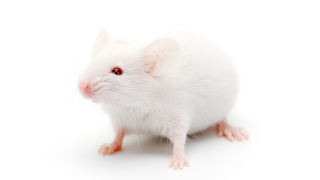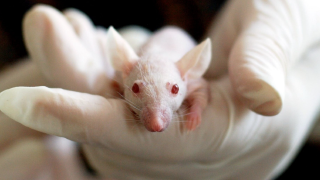Hundreds of thousands of animals worldwide are used every year in an attempt to test the safety of chemicals. These experiments are also called toxicity tests and traditionally involve poisoning guinea pigs, rabbits, rats and mice. We are working to end these tests on both moral and scientific grounds.
- In toxicity tests, animals are force fed, forced to inhale or injected with chemicals to see what dose will sicken or kill them.
- They are not provided with any pain relief.
- Animals can suffer from vomiting, seizures, internal bleeding, organ damage and death. Those who survive are killed at the end of the experiment and their bodies dissected.
Animal safety tests are slow, costly, inhumane and generate results that do not provide what we really need to protect human and ecological health into the future.
Over the last 30 years, there have been significant developments in the replacement of toxicity tests on animals. Non-animal methods have been developed that can now replace wholly, or in part, a number of animal tests across several product sectors. However, our experience has been that actually replacing the animal tests takes much longer than it should. This is unacceptable.
In many cases, the problem lies with failure of authorities to require the use of the non-animal method and the absence of a joined-up approach to acceptance of non-animal tests around the world. If a non-animal method is accepted by regulatory authorities in one country but not in another, the animal test will still be conducted.
A drive to better understand all the chemicals we are exposed to must be underpinned by investment in scientifically sound non-animal hazard testing methods, exposure monitoring methods and risk assessment strategies.
What we do
- Educate decision makers about non-animal methods for testing chemicals
- Lobby for existing laws that require and prioritise the use of non-animal methods to be fully enforced and for new, tougher laws to be put in place
- Work to harmonise international regulations so that modern, humane and human-relevant tests are accepted and outdated animal tests eliminated everywhere
- Meticulously follow the latest developments in non-animal methods and use these as evidence to ensure that the relevant regulatory bodies take them up
- Work to save as many animals as we can by encouraging national and international regulators to challenge the use of animals and accept non-animal methods
- Identify cases where non-animal methods are not being used where they should be, and challenge the relevant companies and regulatory authorities to take action
- Publish scientific papers and briefings raising the problems associated with animal testing and offering solutions for change
We also work with our partner members of the International Council on Animal Protection in OECD Programs (ICAPO) at the to ensure that all opportunities to avoid animal tests and encourage the use of non-animal methods are made possible within the testing guidelines of key international body, the Organisation for Economic Cooperation and Development (OECD).
Our recent achievements
- In 2016, we pushed the European Commission to update the industrial chemicals legislation, also known as the Registration, Evaluation, Authorisation and Restriction of Chemicals (REACH) Regulation to: delete the rabbit skin and eye irritation (Draize) tests (saving 18,000 rabbits), to encourage the avoidance of the cruel dermal acute toxicity test (saving 66,00 rats) and to encourage the use of alternatives to skin allergy testing (potentially saving 200,000 mice).
- To date, we have helped save over 80,000 animals from unnecessary tests proposed by the European Chemicals Agency (ECHA) under the EU’s REACH chemical safety programme.
- Our investigation with SOKO Tierschutz at the Laboratory of Pharmacology and Toxicology (LPT) in Germany and our exposé of the Vivotecnia laboratory in Spain have lifted the lid of secrecy on regulatory safety testing and revealed the shocking levels of animal suffering caused by toxicity testing.
- We contributed to successful efforts to get the OECD to adopt a new ground breaking guideline on Defined Approaches for Skin Sensitisation, employing a selection of non-animal methods that replace cruel tests on mice and guinea pigs to predict whether chemical substances could cause human skin allergies.
What you can do
The simple act of signing a petition, sending an email or going cruelty free could make a real difference to animals in laboratories. Get involved today and help us end animal testing worldwide. Stay informed about important campaigns and how you can help.
Chemicals Campaigns
EU REACH
Europe’s largest animal testing programme
UK REACH
Ending animal testing for chemicals in the UK
#TargetZero for animal experiments in the UK
subtitle: Sign the petition to end animal testing in the UK
Replace Animal Tests: The EU RAT List
subtitle: 10 animal tests that should be replaced
10 animal tests that should be replaced




